|
Open Boat Weekend... |

|
|
By Richard Whitney - Auckland - New Zealand |
...at Islington Bay - and the Wild Ride Home
The idea for the Sail In to Islington Bay was hatched a couple of weekends back when my friend Paul Groom, the owner of a John Welsford designed Pathfinder, Varuna, suggested we sail out to Islington Bay to meet his friend and fellow open boat enthusiast Dave Perillo (owner of a JW designed Navigator, Jaunty and of the website openboat.co.nz). On the Saturday night we were out there we chanced upon David Robertson aboard Blue Jacket (David is the webmaster of woodenboat.net.nz). Dave, David and Paul decided it would be good to have a similar gathering with a bigger group of like minded people. The two web sites were used to promote the event. (we are all based in Auckland, New Zealand and regularly sail on the Waitemata Harbour)
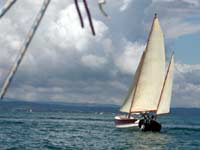 |
Varuna (Pathfinder) under sail
(click images for larger views) |
|
On the weekend of the ‘Sail In’ I sailed my cat ketch rigged Core Sound 17, Kokako (designed by Graham Byrnes of B&B Yacht Designs) from Westhaven (one of the big marinas here in Auckland) the 10 nautical miles to Islington Bay which is formed where Motutapu Island (many millions of years old) joins Rangitoto Island (a volcano only 800 years old).
| Kokako under sail Islington Bay |

|
|
I had lovely run/broad reach down the harbour trying out my recently modified sails which now run up the masts on tracks rather than fitting over them with a sleeve (the new set up make them much easier to reef). When the wind dropped to 15 knots, I shook out my single reef and planed most of the way to the island. At one point a saddle, newly riveted to the mast, popped out due to the strain of the snotter attached to my mizzen sprit when a strong gust came though. Some quick work with some webbing and a D ring had me underway again (but creating a weak point that would come back to bite me later).
I arrived to find a range of small open boats buzzing around the bay. Paul (Varuna), Dave (Jaunty), Lindsay in his JW design Houdini, and Bruce Robinson's Waverider trimaran Manu. Also at anchor was David aboard Blue Jacket, Jason Prew’s Loloma and John Bertenshaw’s Waione. All three are splendid gaff rigged yachts which the next morning would make a magnificent sight heading out of the bay under sail.
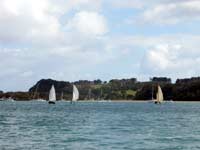 |
Welsford boats buzzing around the bay
|
|
Later that afternoon sailing around with some of the other boats in very gusty conditions - the same thing that had happened earlier in the day happened to the saddle holding the snotter on the main mast- ping. I was near the beach so headed in and used webbing and a D ring to ‘jury rig’ again. I then headed out for some more fun sailing around Islington Bay with the rest of the open boats.
That night we all came ashore (including the families/friends of those on the gaffers) on the beach at the head of the bay for a BBQ and as Dave Perillo put it “… dinner was held on the beach, a decent fire was lit, sausages sizzled, snappers fried and in true sailor fashion stories were told about high sea adventures, boats we’ve known and distant ports visited.” After dinner the open boats headed for a sheltered part of the bay and a variety of tents and tarps sprung up aboard each to protect the crews from the elements.
| Some of the team around the BBQ |
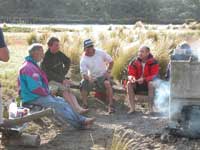
|
|
I woke to the view of the sun rising off the stern after a calm night at anchor. A few feet away Paul, Dave and Lindsay (with three different John Welsford designed boats) were rafted up for breakfast. I joined them and we all had a slow start to the day eating and drinking good coffee. Paul was listening to the weather report on his VHF radio, and I asked him for a summary. He joked, “50 knot westerlies with snow down to sea level”. Little did he know what was waiting for us outside the bay.
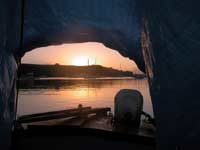 |
Dawn aboard Kokako
|
|
About 11am we sailed out of the bay and started to head back to Auckland with about 15-20 knots on the nose. Beating home in the westerly a massive squall came through (we can get live wind on VHF here – soon after the worst of the squall had passed Paul picked up 37 knots at Bean Rock which was just ahead of us - so it must have been a least 40 knots). Paul in his Pathfinder furled his jib, dropped his main and hove to under mizzen. I dropped the main as far as I could, but the webbing I had placed around the mast the day before as a ‘jury rig’ stopped me getting it down far at all – it was way too choppy and windy to get out on the fore deck to untie it. This is where the ‘weak point’ from the small gear failure the day before with the two lightly riveted saddles popping out comes back to haunt me.
| Rangitoto at dawn |
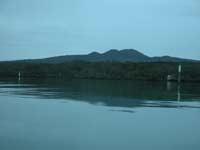
|
|
In the confusion I didn't think about the fact that in dropping the sail the small amount I had been able to I had loosen the snotter. It jumped out of the D ring in a gust and the sprit (still attached to the boat) went over the side. It got stuck under the boat around the centreboard, and when I managed to get the board up, drifted back to foul on the rudder.
At this stage things were looking ugly with a volcanic lee shore coming up quick. I tried to start the outboard – but it kept starting and then cutting out. When I looked over the side I discovered the snotter rope was wrapped around the prop. I finally got the sprit back aboard, but couldn't get the rope free. In the end I managed to unwrap the rope from the prop, started the motor and pulled 6 feet further way from the lee shore –but, yes, another bit of the rope caught around the prop.!! I cleared it again and finally got underway into a strong headwind and steep sea (my 2hp only just did the job.) Lesson One (feedback from Paul) - I should probably have tried to get up on the fore deck to get the anchor out of the hatch and anchor to avoid the near miss with the lee shore - I don't know how I would have gone if I had thought of it.
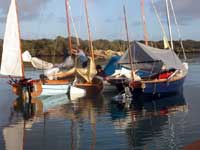 |
Welsford raft-up
|
|
I tidied things up, got the webbing off the main mast and dropped the main and stowed it up forward. I sheeted in the mizzen to stop it flapping, as I was going straight into the wind (another mistake). About five minutes later a slightly chaotic racing fleet approached me still racing in the strong wind. I was under power and a keel boat close hauled on a starboard tack, was coming straight at me. I could see I couldn't clearly pass in front of her – so I changed my course to pass behind her - not thinking of the mizzen sheet in hard. Another strong gust hit at that point and ripped the mizzen mast through the thwart that supports it amidships. It also split the fibreglass top of the mizzen mast.
| A good latte to start the day |
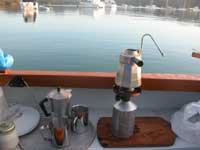
|
|
I derigged the mizzen - got everything onboard and strapped in and started a long slow trip back using the 2hp Honda into a strong head sea and wind. At this point I looked somewhat like a jouster with my mizzen mast poking forward like an extended bow sprit.
The next thing to happen was the outboard ran out of petrol (gas) and the wind pivoted the boat and started to blow me back where I had come from. I re-filled and limped home.
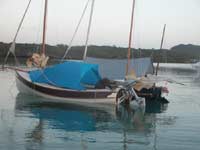 |
Paul and Lindsay
|
|
The boat is now cleaned up and back in the garage. It was all a good (if slightly too exciting) experience. I learned a number of valuable lessons and identified some parts of the boat I had under built and needed to ‘beef up’. All of that being said - the open boat weekend was great – and the ‘wild ride’ a valuable test in extreme conditions.
Paul and Dave's boat with their heavy centreboards rode out the front better than my much lighter boat, although I heard from Dave that he had some gear failure as well. When I went into the place I buy my boat bits the week after they said they had been doing a roaring trade that week with lots of people coming in having to do repairs (so it wasn’t just me.)
| Open boats off the beach at Islington Bay |
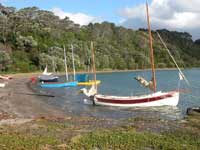
|
|
The weekend after, having consulted with the designer of my boat, Graham Byrnes, I beefed up the thwart that supports the mizzen mast with two extra layers of ¼ inch ply underneath, tapped stainless steel screws into the masts to hold the saddles for the snotter connections, mended the fibreglass tip of the mizzen mast and generally went right over the boat and rig to make sure everything was ship shape. Graham passed on to me a quote from his mentor which was, ‘if it is an important fitting through bolt it, and if you can’t do that – through bolt it.” The lesson I learned as a builder was how ever good a design is you can let yourself down by under building even a couple of small things.
I will be back in the water this weekend, wise and stronger (the boat anyway) and with a real understanding that a boat is only as strong as its weakest point.
Richard Whitney

|